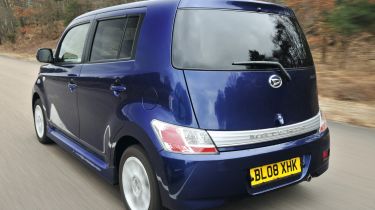Daihatsu Materia
Boxy shape helps Japanese model stand out from crowd
The Materia is the joker in this pack, but why? Well, at £10,770, the Daihatsu undercuts the Kia Soul by a huge £2,725. Does such a large price difference mean the Materia is out of its depth – or is it simply great value?
Take a look at its dimensions, and the model could have used any of the three other cars here as a template, but Daihatsu’s designers went their own way when penning the exterior looks.
Like it or loathe it, the boxy shape is certainly distinctive, with flat body panels and an upright stance. Younger drivers will appreciate the chunky bodykit and darkened rear windows, but owners of all ages have to get used to being stared at.
Inside, and away from prying eyes, the Materia delivers a surprising amount of space. It has the same wheelbase as the C3 and, as with the Citroen, rear passengers sit on a sliding bench. There’s a decent amount of legroom, while the high roofline means only occupants standing six feet tall will find their heads close to the ceiling.
Unfortunately, a small boot compromises the car’s practicality. With the back seats in place, there’s a maximum of 294 litres of space to play with, and dropping them only liberates an extra 325 litres.
Used - available now

2022 BMW
X1
65,606 milesAutomaticPetrol2.0L
Cash £17,997
2022 Kia
XCeed
21,989 milesAutomaticPetrol1.6L
Cash £16,497
2021 Ford
Fiesta
46,167 milesManualPetrol1.0L
Cash £11,897
2022 Vauxhall
Mokka
38,205 milesManualPetrol1.2L
Cash £12,697There’s also a shortfall in the number of useful cubbyholes inside, so storing family clutter is more of a problem than in any of its rivals. The narrow door bins are particularly impractical, and hold no more than a few CD cases. But the biggest problem is the Daihatsu’s finish. After you spend time in the Citroen, the Japanese car is low rent. The plastics look brittle and feel hard, while build quality is average, so you can hear the odd rattle on the move.
At least the Materia does try to be different. Its instruments are positioned in a centrally mounted pod, and the insides of the door handles and the speaker surrounds glow blue at night.
At the test track, the Daihatsu performed strongly, recording a respectable time of 10.2 seconds for the sprint from 0-60mph – a figure only the Nissan could beat. The trouble is, the 102bhp 1.5-litre powerplant feels so strained at high revs that you’re discouraged from using its full potential.
Compensating for this is the fact that the Materia’s brakes are the most effective here. Thanks to its 1,035kg kerbweight, the Daihatsu stopped from 70mph in only 46.7 metres – over a metre less than its nearest rival.
On the road, the Materia feels secure and predictable, but through corners there’s little enjoyment from behind the wheel. The firm suspension also compromises ride comfort, crashing noisily over broken surfaces.
Where the Materia really scores is around town – light controls and good visibility make it really easy to drive.
With its attractive price, distinctive looks and spacious interior, the Daihatsu holds plenty of appeal. But it feels cheaper than its rivals and lacks some of their practicality. The question is whether that will be decisive in the final reckoning.
Details
Chart position: 4
WHY: Quirky design and low prices mark the Materia out as something different. But can it take on its mainstream rivals?







